
The existing evidence on whether women with carotid stenosis experience inferior treatment outcomes compared to men is mixed—and this uncertainty is reflected in the current clinical guidelines. Seemant Chaturvedi (Baltimore, USA) assesses this evidence and outlines how it may impact treatment approaches.
One of the leading causes of ischaemic stroke is internal carotid artery (ICA) atherosclerosis. While several studies have been devoted to studying carotid interventions, such as carotid endarterectomy (CEA) or carotid artery stenting (CAS), many of the studies devoted to analysing the effects of intensive medical therapy are outdated.
Another area where the decision-making data are suboptimal concerns ICA stenosis narrowing in women. Early studies, such as ACAS (Asymptomatic Carotid Atherosclerosis Study), showed a reduction with CEA in asymptomatic men but not in women. Similarly, early trials dedicated to symptomatic ICA stenosis showed reduced benefit in women compared to men. In an analysis of patients with 50–99% stenosis who received either CEA or medical therapy, the number needed to treat to prevent one stroke was nine for men, and 36 for women.
These observations led to questions about whether the biology of carotid disease differs in men versus women. Pathologic studies regarding CEA plaque specimens showed lower macrophage infiltration in plaques from women. In addition, smooth muscle content was higher in women. These findings led to the opinion that plaques from women could have a more stable phenotype. The more stable phenotype may be related to the trial observation that women had less benefit from CEA.
Radiologic studies have also shed light on differences in carotid stenosis between men and women. Plaque imaging studies have identified a lower rate of intraplaque haemorrhage and lower frequency of lipid-rich necrotic core in plaques from women. Once again, these findings may be related to the observation that women have a lower stroke risk while being treated with medical therapy.
When putting this all together, are the data sufficient to recommend a different approach for women with carotid stenosis? Some argue that the enrolment of women with carotid stenosis has been suboptimal in clinical trials (ranging from 25–35%) and that we should not reach clinical decisions based on subgroup analysis. Others argue that the pathologic and radiologic data resonate well with clinical observations, and that the data should not be ignored. Proponents of this view argue that carotid intervention should be offered less frequently to women.
Finally, clinicians should consider whether a separate women’s carotid stenosis trial is worthwhile. Such a trial could test intensive, modern medical therapy versus intensive medical therapy plus revascularisation. This trial would be unique in the current stroke prevention landscape and could settle a controversial issue.
Further reading:
- Marulanda-Londone E, Chaturvedi S. Carotid stenosis in women: Time for a reappraisal. Stroke Vasc Neurol. 2016; 1(4): 192–6.
- Gasbarrino K, Di Iorio D, Daskalopoulou S S. Importance of sex and gender in ischemic stroke and carotid atherosclerotic disease. Eur Heart J. 2022; 43(6): 460–73.
Seemant Chaturvedi is the Stewart J Greenebaum endowed professor of Stroke Neurology and director of the UMMS Stroke Program at the University of Maryland School of Medicine in Baltimore, USA.













